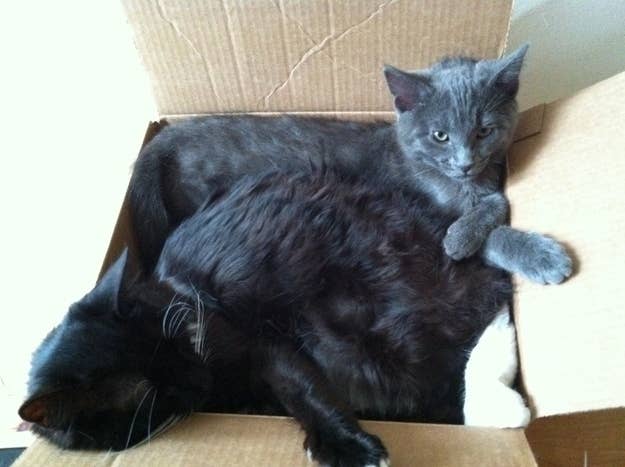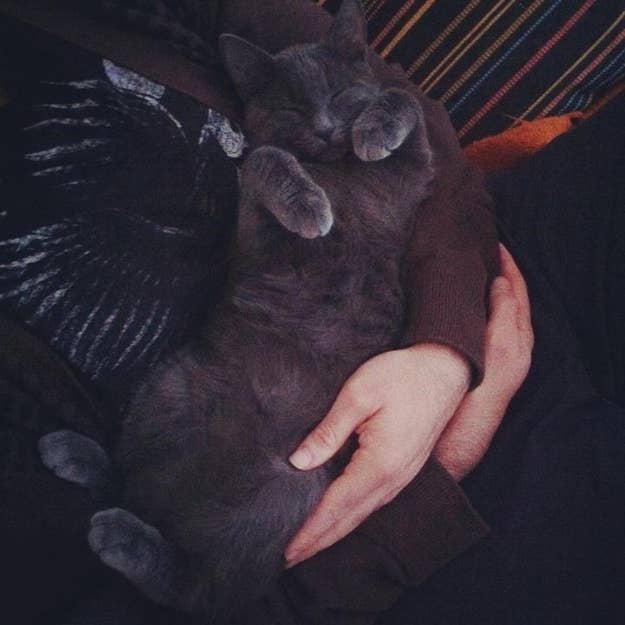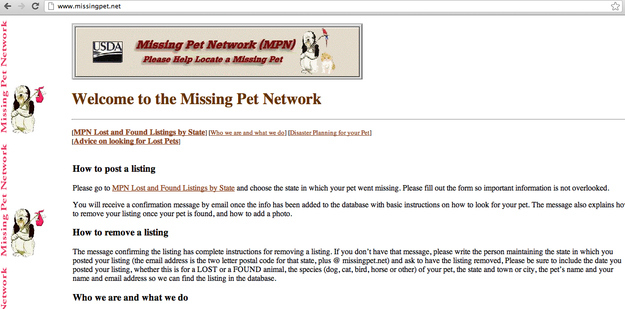
Before I opened the door to my house, I could tell something was amiss: the 11-month old cat, Squeaky, that I share with my boyfriend, was not in the window. And when we got inside the house and our 6-month grey old kitten, Riff Raff, was not hovering near the door, it was clear. They were gone.
FUCK. FUUUUUCK. My brain divided in half. They are cats, I told myself, cats take care of themselves. Cats come back. No, the other side argued, these are city cats who barely know how to eat, let alone hunt. And Riff Raff is still little! He'll run right into traffic. As if on cue, someone's brakes squealed, a siren started blaring and a car alarm sounded: we live on a busy street. My legs went wobbly. The animals weren't wearing collars.
And our options seemed pretty pitiful. It was nighttime and our neighbor, the one who had accidentally left the back door open while moving a desk out of the basement, said it had been nine hours since she had been in the house. Nine hours! What could we do? Call out their names? Make posters? Ring doorbells? Try Animal Care and Control? My iPhone can be tracked across the country. Surely, there must be something better than fliers for our cats.

The first stop on my computer pet search were microchip sites. Both cats were microchipped, so if they got brought into ASPCA or Animal Care and Control, they'd be identified. I called in and told a nice woman that the cats should be marked as "lost." She made some clucking noises, gave a few basic tips (put a litter sample outside, make flyers) and wished me luck.
It turns out that beyond that there are a range of different tech options, although many are expensive, limited in effectiveness, and designed for larger animals than my two babies.
Apps. Programs do exist: for $5, I could register my cats with LostPetTracker; it'd send my alert out to everyone else with the app, and then whenever someone found or lost a pet in my area, I would get an email. This seemed ... pointless. If someone happened to spot my cats and took a picture and uploaded it to the service, it would be geolocated and time-stamped, but the odds of that happening seem slim. Other apps, like PetRescuers, similarly depend on good Samaritans to download an app and make reports of loose animals. iPet Alert notifies vets as well as app users to be on the lookout, but, again, that requires opt-in. These apps are virtual pet flyers (those goddamn pet fliers!), but seem like they'd be less effective than just posting a notice on Craigslist or another local site.
Collars/trackers. When the animal shelter told me that my cats would be microchipped, I thought that that meant they could be geolocated if they were lost. Sadly, this is not the case: GPS units need power and no one has figured out a way to add tiny batteries to the inside of a cat. It is possible, though, to put that equipment on an animal's collar . Tagg, a leader in the field, works much like an iPhone finder: put a dongle on the animal's collar and Tagg uses cell phone networks to track it. You can establish a perimeter and get texts and emails if the pet breaks out. And the animal's location can be tracked from your phone or computer.
I spoke to Tagg's senior director of sales and marketing, Dudley Fetzer, about the technology. Tagg was launched about a year ago and it's owned by Qualcomm, the maker of the geolocation chips inside almost every cell phone. The company had been looking for ways to create tracking products (think of package tracking) and a team of pet-lovers within the company gravitated towards this effort. Unfortunately, for beasts like Riff Raff and Squeaky who weigh less than ten pounds, Tagg isn't recommended due to the size of the antennas that need to be attached to tracker. (This is not an insurmountable problem, though, as Fetzer said they've heard from numerous cat owners whose cats don't mind the device.) Fetzer couldn't comment on the number of units sold but said the product has been a great success. "We save several pets on a daily basis," he noted. And just next week, Tagg will be rolling out a new service that tracks pets' movements and awards points for exercise. It's like a juiced up pedometer, a Fitbit: meet the quantified pet.
But the costs are not insignificant. The Tagg tracker costs $99 with a monthly service charge around $8. Other GPS locators run even more: SportDog Tek training and locator collars and handsets cost up to $550. And these devices are mostly designed for dogs: none of the GPS-enabled collars that I saw would fit cats at all.
View this video on YouTube
No so sure about the "keep your dog off the pole" tagline.
Websites. I once did a story on a pet detective. We spent a macabre (but fascinating) day with her two cadaver-trained dogs, looking for a lost Chihuahua — or, more accurately, its remains. Like in any investigation, the pet detective told me, the first 48 hours were crucial, and one's attention should be focused on getting the word out in the vicinity closest to the animal's last known location. In other words, PET FLIERS.
As clunky as they seem, pet fliers are one of the most effective tools for finding an animal, and many have tried to translate that utility online. Craigslist, obviously, is a popular spot, but there is also Get Pets Home (a site where you can also get a scannable collar tag loaded with pet info, essentially an above-skin microchip), PetHub (another tag), Missing Pet Network (sad clip art), Fido Finder, Lost Pet USA and more. But after logging and looking, I felt exhausted and sad: who will know to look at a specific site to find a pet? As Fetzer noted, most of the available technologies are about waiting, not proactive search.

And the waiting is the worst. After I had told the microchip companies (the cats were registered to different services) that they were lost, I sat on my couch, feeling helpless. Following the microchip lady's instruction, my boyfriend and I put out some of the kitty litter, and some food just 'cause. We walked around the block, knocking on doors while our poor, guilt-stricken neighbor began putting together a flier. I took a flashlight and looked under the house. It was now after 10 p.m.
Finally I went back inside and just broke down. Tears, foot-stomping, shaking hands, the works. I know this is a bit dramatic but it was really scary, not knowing exactly what to do and picturing dead Riff Raff on the side of the road. But then, just when I was really losing it, burrowing my face into my boyfriend's jacket, the fucking cat just strolled in. A minute later, Squeaky appeared. Their whiskers were heavy with god-knows-what and they both immediately sat down and started scratching what I assumed were fleas, but they were otherwise fine.
The whole episode lasted perhaps two hours. We got very lucky. Putting a cat outdoors in the city cuts its life expectancy by almost two-thirds — just the previous week, I had seen some mangled heap of cat fur a few blocks from our house. Of all the available products, Tagg seemed to be the best, as the device is small, the technology sound, the app easy to understand. But according to Dr. Jennifer Scarlett, co-president of the San Francisco SPCA, even the best tech products on the market are still lacking. "I don't, at this time, have anything to recommend," she said. She noted that GPS trackers like Tagg, with limited battery power and clunky attachments, have "limited use." "Eventually there might be some technology that can be put into a microchip," she said, "That would be more useful."
For now, my bad cats will get collars and constant surveillance. "I hope you enjoyed your time out there," I told Riff Raff, picking out the bits of plant from his fur, "Because you'll never see the light of day again."
Note: if you have any desire to see more pictures of my cats, feel free to email me: reyhan.harmanci@buzzfeed.com. Lots more where that came from.


